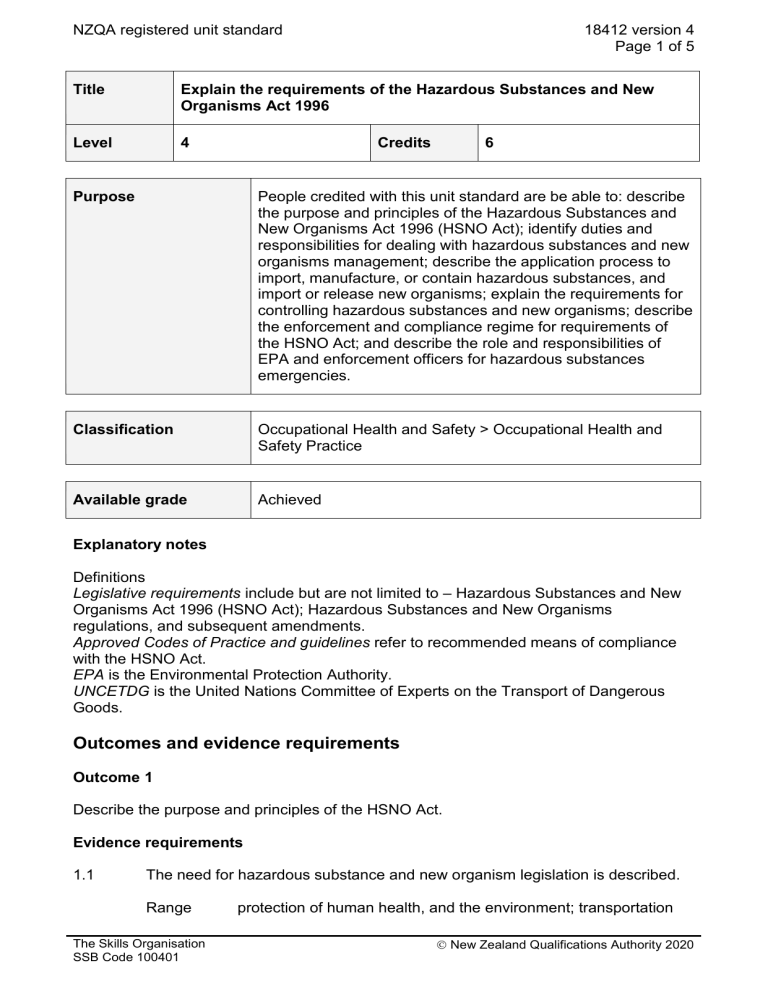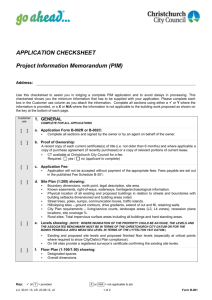NZQA registered unit standard 18412 version 4 Page 1 of 5

NZQA registered unit standard
Title
18412 version 4
Page 1 of 5
Explain the requirements of the Hazardous Substances and New
Organisms Act 1996
Level
Purpose
4 Credits 6
People credited with this unit standard are be able to: describe the purpose and principles of the Hazardous Substances and
New Organisms Act 1996 (HSNO Act); identify duties and responsibilities for dealing with hazardous substances and new organisms management; describe the application process to import, manufacture, or contain hazardous substances, and import or release new organisms; explain the requirements for controlling hazardous substances and new organisms; describe the enforcement and compliance regime for requirements of the HSNO Act; and describe the role and responsibilities of
EPA and enforcement officers for hazardous substances emergencies.
Classification Occupational Health and Safety > Occupational Health and
Safety Practice
Available grade Achieved
Explanatory notes
Definitions
Legislative requirements include but are not limited to – Hazardous Substances and New
Organisms Act 1996 (HSNO Act); Hazardous Substances and New Organisms regulations, and subsequent amendments.
Approved Codes of Practice and guidelines refer to recommended means of compliance with the HSNO Act.
EPA is the Environmental Protection Authority.
UNCETDG is the United Nations Committee of Experts on the Transport of Dangerous
Goods.
Outcomes and evidence requirements
Outcome 1
Describe the purpose and principles of the HSNO Act.
Evidence requirements
1.1 The need for hazardous substance and new organism legislation is described.
Range protection of human health, and the environment; transportation
The Skills Organisation
SSB Code 100401
New Zealand Qualifications Authority 2020
NZQA registered unit standard 18412 version 4
Page 2 of 5 safety; international obligations under transmutual recognition agreement; the globally harmonised chemical classification system; biosafety protocol.
1.2 The purpose and key principles of the HSNO Act are explained in accordance with legislative requirements.
1.3 The coverage of the HSNO Act is described in accordance with legislative requirements.
Range includes importers/manufacturers/product developers, users, transport and waste disposal companies, operators of containment facilities, handlers of highly hazardous substances, specialists, enforcement officers.
1.4 Terminology used under the HSNO Act is defined.
Range includes but is not limited to – substance, hazardous substance, organisms, new organism, compressed gases, by-products, acute, chronic, ecotoxicity, bio-accumulation, oxidise, containment, genetically modified organisms.
Outcome 2
Identify duties and responsibilities for dealing with hazardous substances and new organisms management.
Evidence requirements
2.1 Powers and duties of EPA are described in accordance with legislative requirements.
Range includes but is not limited to
– makes decisions on the methodology for assessing hazardous substances and new organisms, determine required control measures, maintain public register, approve test certifiers and Codes of Practice, monitor compliance and enforcement of the HSNO Act, enquire into incidents, advise and assist Minister, assist people in the management of hazardous substances, promote public awareness.
2.2 Powers and duties of enforcement officers are described in accordance with legislative requirements.
Range provide advice and information, promote and monitor compliance, provide information to EPA, carry out enforcement functions.
2.3 General duties of people who import, possess, or use hazardous substances or new organisms are explained in accordance with legislative requirements.
Range avoid, remedy, and mitigate adverse effects of hazardous substances.
The Skills Organisation
SSB Code 100401
New Zealand Qualifications Authority 2020
NZQA registered unit standard 18412 version 4
Page 3 of 5
Outcome 3
Describe the application process to import, manufacture, or contain hazardous substances, and import or release new organisms.
Evidence requirements
3.1 The application process to import, manufacture, or contain hazardous substances is explained in accordance with EPA guidelines.
3.2 The application process to import or release new organisms is explained in accordance with EPA guidelines.
Outcome 4
Explain the requirements for controlling hazardous substances and new organisms.
Evidence requirements
4.1 The process of assigning hazard controls is described in accordance with EPA guidelines.
Range performance based approach, type of hazard, hazardous property, pan-life cycle, degree of hazard, regulations and codes of practice.
4.2 The hazard classification system is described in relation to hazardous substances control.
Range includes
– explosiveness, flammability, oxidising ability, corrosivity, toxicity, ecotoxicity, UNCETDG, class, category.
4.3 Pan-life cycle controls are identified in accordance with legislative requirements.
Range packaging and containment, identification/labelling/signage, competency of handlers, emergency preparedness, tracking, disposal.
4.4 Other controls and alternative means of control are described in accordance with legislative requirements.
4.5 The test certificate regime is described in accordance with legislative requirements.
4.6 People who must comply with control requirements are identified in accordance with organisational requirements.
4.7 Requirements for controlling new organisms in containment are described in accordance with legislative requirements.
Range limiting likelihood of escape, minimising the effects of an accidental escape, inspection and monitoring, other controls for
The Skills Organisation
SSB Code 100401
New Zealand Qualifications Authority 2020
NZQA registered unit standard 18412 version 4
Page 4 of 5 genetically modified organisms.
Outcome 5
Describe the enforcement and compliance regime for the requirements of the HSNO Act.
Evidence requirements
5.1 The role of EPA and enforcement officers is described in accordance with legislative requirements for compliance.
Range includes – voluntary compliance, self-responsibility, codes of practice, industry standards, guidelines, mandatory compliance, infringement notices, compliance orders, test certificates, powers of enforcement officers.
5.2 Offences, penalties, liabilities and defences are described in accordance with legislative requirements.
Range
Outcome 6 fines, imprisonment, other penalties, defences, rights of appeal.
Describe the roles and responsibilities of EPA and enforcement officers for hazardous substances emergencies.
Evidence requirements
6.1 Hazardous substances and new organisms emergency scenarios are identified in terms of actual or imminent danger to human health or the environment, in accordance with organisational requirements.
6.2 Actions for cleanup and compensation rights are identified in terms of legislative requirements.
6.3 Powers of enforcement officers and emergency agencies are described in accordance with legislative requirements.
Planned review date 31 December 2015
Status information and last date for assessment for superseded versions
Process Version Date Last Date for Assessment
Registration
Revision
Review
Rollover and
Revision
1
2
3
4
31 July 2001
16 May 2005
25 May 2007
22 May 2014
N/A
N/A
N/A
N/A
The Skills Organisation
SSB Code 100401
New Zealand Qualifications Authority 2020
NZQA registered unit standard 18412 version 4
Page 5 of 5
Consent and Moderation Requirements (CMR) reference 0003
This CMR can be accessed at http://www.nzqa.govt.nz/framework/search/index.do
.
Please note
Providers must be granted consent to assess against standards (accredited) by NZQA, before they can report credits from assessment against unit standards, or deliver courses of study leading to that assessment.
Industry Training Organisations must be granted consent to assess against standards by
NZQA before they can register credits from assessment against unit standards.
Providers and Industry Training Organisations, which have been granted consent and which are assessing against unit standards must engage with the moderation system that applies to those standards.
Requirements for consent to assess and an outline of the moderation system that applies to this standard are outlined in the Consent and Moderation Requirements (CMR). The
CMR also includes useful information about special requirements for organisations wishing to develop education and training programmes, such as minimum qualifications for tutors and assessors, and special resource requirements.
Comments on this unit standard
Please contact The Skills Organisation reviewcomments@skills.org.nz
if you wish to suggest changes to the content of this unit standard.
The Skills Organisation
SSB Code 100401
New Zealand Qualifications Authority 2020



